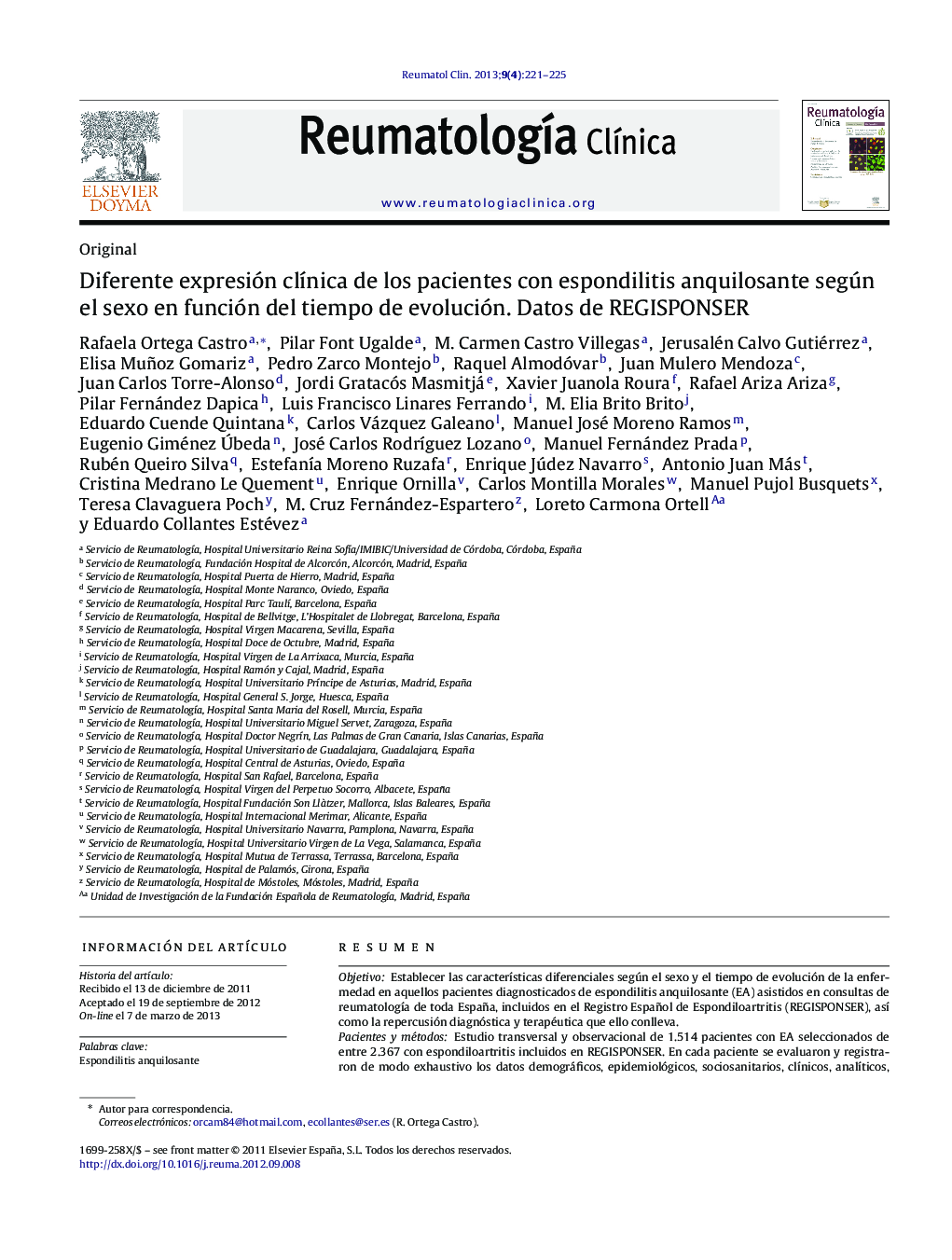| کد مقاله | کد نشریه | سال انتشار | مقاله انگلیسی | نسخه تمام متن |
|---|---|---|---|---|
| 3382985 | 1220432 | 2013 | 5 صفحه PDF | دانلود رایگان |

ResumenObjetivoEstablecer las características diferenciales según el sexo y el tiempo de evolución de la enfermedad en aquellos pacientes diagnosticados de espondilitis anquilosante (EA) asistidos en consultas de reumatología de toda España, incluidos en el Registro Español de Espondiloartritis (REGISPONSER), así como la repercusión diagnóstica y terapéutica que ello conlleva.Pacientes y métodosEstudio transversal y observacional de 1.514 pacientes con EA seleccionados de entre 2.367 con espondiloartritis incluidos en REGISPONSER. En cada paciente se evaluaron y registraron de modo exhaustivo los datos demográficos, epidemiológicos, sociosanitarios, clínicos, analíticos, radiológicos y terapéuticos previstos en el protocolo de REGISPONSER que componen el Conjunto Mínimo Básico que identifica la enfermedad. La función física se evaluó mediante «Bath Ankylosing Spondylitis Functional Index». La actividad clínica mediante velocidad de sedimentación globular, proteína C reactiva y «Bath Ankylosing Spondylitis Disease Activity Index» (BASDAI). A cada paciente se le realizaron radiografías anteroposterior de pelvis, anteroposterior y lateral de columna lumbar y lateral de columna cervical, y se puntuaron según el índice «Bath Ankylosing Spondylitis Radiographic Index Spine» (BASRI-Spine), que mide el daño estructural.ResultadosDe los 1.514 pacientes seleccionados, 1.131 (74.7%) eran hombres. Encontramos que existen diferencias significativas en la edad tanto al inicio de los síntomas como en el día de la inclusión entre ambos grupos, siendo menor en los hombres. También obtuvimos diferencias en el tiempo de evolución de la enfermedad, que fue menor en el grupo de las mujeres. En cuanto a la existencia de antecedentes de EA entre los familiares de primer grado, las formas familiares fueron más frecuentes entre las mujeres, también resultó superior en éstas la puntuación media del BASDAI, con independencia del tiempo de evolución. Por el contrario, la mejoría del dolor con la toma de antiinflamatorios no esteroideos fue mayor en el caso de los hombres, así como la severidad radiológica, ambas de forma significativa.ConclusionesEntre los pacientes con EA españoles existen algunas diferencias en las manifestaciones clínicas y cuando se controló según el tiempo de evolución, también encontramos diferencias radiológicas según el sexo; los hombres muestran más daño estructural, mientras que las mujeres presentan mayor actividad. Estos datos sugieren que el fenotipo de EA difiere entre géneros, lo que puede influir en el manejo diagnóstico y posterior elección terapéutica.
ObjectiveTo describe the differential characteristics by gender and time since disease onset in patients diagnosed with ankylosing spondylitis (AS) attending the Spanish rheumatology clinics, including those on the “Spanish Registry of spondyloarthritis” (REGISPONSER), as well as the diagnostic and therapeutic implications that this entails.Patients and methodsThis is a transversal and observational study of 1514 patients with AS selected from 2367 spondyloarthritis cases included in REGISPONSER. For each patient, the demographics, epidemiology, geriatric, clinical, laboratory, radiological, and therapeutic aspects were were evaluated and comprehensively recorded under the aegis of REGISPONSER, constituting the Minimum Basic identifying data for the disease. Physical function was assessed by Bath Ankylosing Spondylitis Functional Index (BASFI). Clinical activity was evaluated using erythrocyte sedimentation rate, C reactive protein and Bath Ankylosing Spondylitis Disease Activity Index (BASDAI). Each patient underwent pelvic anteroposterior, anteroposterior and lateral lumbar spine as well as lateral cervical spine x rays; they were scored according to the Bath Ankylosing Spondylitis Spine Radiographic Index, which measures structural damage.ResultsOf the 1514 patients screened, 1131 (74.7%) were men. We found significant differences in age at onset of symptoms as well as in the day of inclusion, between the two groups, being lower in men. We also obtained differences in the duration of the disease, which was lower in women. As for the existence of a history of AS among first-degree relatives, family forms were more common among women. The mean BASDAI score was also higher in women, regardless of time since onset of disease. In contrast, the improvement of pain with the use of NSAID's and radiological severity were higher in men, both reaching statistical significance.ConclusionsAmong the Spanish AS patients, there are some differences in the clinical manifestations, even when the time since onset of disease was controlled; we also found radiological differences by gender; men showing more structural damage, while women were more active. These data suggest that the phenotype of AS differs between genders. This can influence the subsequent diagnostic approach and therapeutic decisions.
Journal: Reumatología Clínica - Volume 9, Issue 4, July–August 2013, Pages 221–225